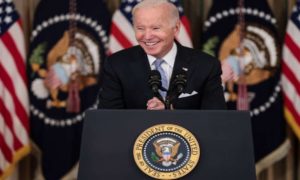WASHINGTON — President Joe Biden on Monday announced an economic agreement with more than a dozen countries to counter China’s influence and reinforce global supply chains, administration officials said.
The news comes as Biden meets with Japanese Prime Minister Fumio Kishida in Tokyo during the second leg of his first presidential trip to Asia.
Initial participants in the Indo-Pacific Framework include 13 countries, from major economies — like Australia, Japan, India and South Korea — to developing ones, including Indonesia, the Philippines, Malaysia, Thailand and Vietnam. It also includes smaller countries like Brunei, New Zealand and Singapore.
Together, they represent about 40 percent of global gross domestic product, the officials said.
“It is by any count the most significant international economic engagement that the United States has ever had in this region,” Commerce Secretary Gina Raimondo told reporters ahead of the announcement.
The pact is about “restoring U.S. economic leadership in the region” and “presenting Indo-Pacific countries an alternative to China’s approach,” she added.
Notably, however, the initial list does not include Taiwan, a self-ruling island that China claims as its territory. Speaking to reporters Sunday, national security adviser Jake Sullivan said the U.S. was looking to deepen its economic relationship with Taiwan on a bilateral basis.
Officials said the deal would focus on four “pillars” — supply chain resiliency, clean energy and decarbonization, tax and anti-corruption, and enhanced trade.
Sullivan differentiated the framework from past trade deals, such as the Trans-Pacific Partnership, or TPP, another pact meant to counter China negotiated during the Obama administration.
That deal faced opposition from both the left, especially organized labor, and the right, largely from the GOP’s growing nationalist wing. President Donald Trump pulled out of the TPP shortly after he took office in 2017, effectively killing it.
“Our fundamental view is that the new landscape and the new challenges we face need a new approach, and we will shape the substance of this effort together with our partners,” Sullivan said.
Led by Japan, the 11 other countries that were in the TPP signed a successor agreement called the Comprehensive and Progressive Agreement for Trans-Pacific Partnership, or CPTPP, which China is trying to join.
Several countries in the CPTPP, like Mexico and Canada, are not included in the Indo-Pacific plan, which Sullivan said includes a wider range of countries.
“You’ve got major economies, emerging economies, economies with which we have free trade agreements and others for which this will be the United States’ first economic negotiation,” Sullivan said.
Still, the framework is just that for now, and leaders will need to negotiate before anything is finalized.
“It will be a negotiation which will begin post-launch,” Raimondo said. “I would say the greatest enforcement is that if you don’t hold up your end of the bargain, you don’t receive the benefits. And so there will be incentive to go ahead and live up to the commitments that will be part of the agreement.”





















